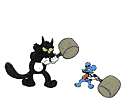
















|

CLOSE TO THE TABLE LONG PIPS ATTACK AND DEFENSE TECHNIQUES
By: Richard McAfee, USATT Certified National Coach
Many of my senior (Over 40) students have
asked me to do an article on the use of long pips, for close-to-the-table play.
This style is very popular with the older table tennis players as it allows them
to slow down play and to put the focus on using their hand skills rather than
movement and power to win points.
Table tennis robot
training is particularly useful when learning and practicing these techniques as
few players can consistently attack against this style. In fact, as you are
learning this style many players may become frustrated and not want to practice
with you at all.
Let's take a look at the
six basic strokes that should be in the arsenal of any close-to-the-table long
pips player. All of these strokes are described as backhand strokes.
- Lift against
backspin: This stroke is executed with a slightly open paddle. The stroke
itself is very simple. At contact, push forward and slightly up. Use mostly
the forearm and little or no wrist action. This stroke, when executed with
long pips, allows you to use your opponent’s backspin to produce a controlled
topspin attack. This is the only stroke in which you can produce enough
topspin to hit with speed.
- Sidespin attack
against backspin: This is an unusual looking stroke to most inverted
players. The stroke is executed much like the straight lift against backspin,
but at contact, the racket is pushed forward and pulled to the right (for
right-handed players). Depending on the racket angle this return will produce
a wide range of no-spin, sidespin, or light topspin returns, all with some
degree of sidespin. This stroke can force many errors from your opponents.
- Attacking backspin
by pushing: Pushing with long pips can be very aggressive. While pushing,
if light contact with the ping pong ball is made, the return will be a dead
ball (no-spin). If harder racket contact is made (more force), a light topspin
can be produced. This leads to a lot of high and very attackable returns from
your opponent.
- Controlled counter
attacks: The key to attacking with long pips against topspin is to
remember that controlling the speed of your returns is the key to success. Do
not over-hit. Your returns will carry some backspin, so there will always be a
limit on the amount of speed you can produce. Generally speaking, if you are
using long pips without sponge this stroke will be quite slow and carry
heavier backspin. If you are using long pips with sponge, this return will be
faster but without as much spin. Once again, keep the stroke simple using only
a forward pushing motion, with the forearm. Remember, when counter attacking
with long pips, let the racket do the work for you. It is the ever-changing
spin on your returns that will force errors from your opponent, not the speed
of your returns.
- Defensive chop
blocks: This stroke looks just like its name suggests—a block with a
downward chopping motion. When used against heavy topspin, this stroke can
produce heavy chop returns. Often your opponent will be forced into pushing
this return back, which will allow you to attack.
- Pullback block:
Once again, the name says it all. Against a topspin attack, you simply pull
your racket slightly back at contact, thereby taking almost all of the pace
off the ball. This can be used to produce a very short return making it
impossible for your opponent to continue an attack. This technique works best
with long pips without sponge.
There you have the major
long pips, close-to-the-table techniques. When used properly, these table tennis
strokes can make life very difficult for your opponents. Fortunately, your robot
will not mind at all while you practice and perfect these techniques.
Courtesy of
Newgy Industries
Copyright © 2002 Newgy Industries. All rights reserved.
|
|